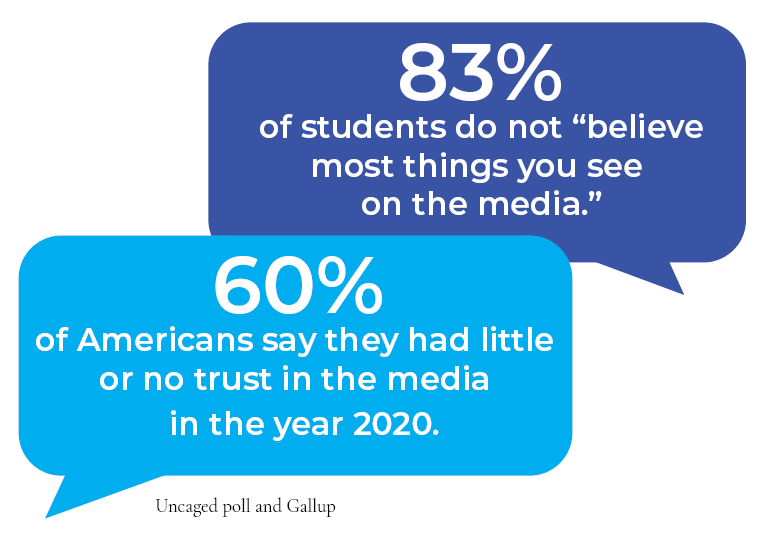Rise in misinformation lowers trust in media
People have lost trust in the media. 6 in 10 US adults found the media to be untrustworthy, according to a story on the impacts of misinformation done by Gallup.
Much of the media is now known for their misinformation and trying to sway the public’s opinions through stories and social media posts. These untruthful stories are often viewed more times than stories with factual information.
Trust in American media has been low with 60% of Americans saying they had little or no trust in the year 2020 according to Gallup.
A factor in this is the rise of misinformation on social media sites like Facebook where, according to a poll, 29% of high school students get their news.
“It’s funny that most of my family members get into arguments on Facebook over stuff that’s not even true,” junior Alyssa VanHook said.
Recently, an ex-Facebook employee named Frances Haugen revealed that although the company was fully aware of the amount of false information on the site, they chose not to act on it. Haugen claimed that they were encouraging its spread with the algorithm in order to gain more profit.
According to the Washington Post, misinformation on Facebook receives 6 times more interactions than factual news. According to an article posted to Forbes in February, Facebook has tried to combat this by pushing reliable information and deleting millions of posts spreading misinformation on COVID-19.
COVID-19 misinformation has been a large concern for many Americans with 74% of them being worried about finding reliable information in 2020 according to Statista.
“There are things that I do believe because I can look it up and see if it’s right,” senior Makayla Myers said, “But I think maybe 80% or 90% of information on social media isn’t true.”
Myers isn’t the only student who thinks this. According to a poll sent to gather information about students’ news consumption habits, 83% of students tend not to believe most of the information they see on social media.
“They’re not factual unless you actually do your research,” junior Makayla Surline said in regards to believing things that are said in the media.
The most popular news sources among students are TV news channels like FOX and CNN, with 57% of students indicating them as a source, and social media app Tik Tok with 43% of students gathering their news there.
“It’s really easy to give out misinformation on social media because it’s not a cited source,” Myers said, “It’s just what someone else is saying.”
The least popular news sources were newspapers with only 11% of students using them as a source and Snapchat with 18% of students getting news there.
Trust of the media is also lower among Republicans than Democrats, with only 10% of Republicans claiming to have a high amount of trust in the media in 2020. This could be because of the great political division in America. The number of Democrats was much higher, with 73% of them trusting the mass media according to Gallup.
“I think society is very divided, especially in our school. You’re either very far right or your very far left,” said Maddie Dalton, “The misinformation in the media really influences that because a lot of people are stupid enough to believe the lies.”
The trust may be low because 59% of Americans believe that most news sources are pushing an ideology or attempting to sway public opinion. Many believe that news sources are focusing less on informing people and have instead prioritized pushing their ideas on their audience, according to Forbes.
A large number of high school students agree that sources attempt to convince people to believe the organization’s own ideas, with 88% of them answering this way in a poll. This could be a result of subconscious biases held by the writer.
“I feel like misinformation is the leading cause of political divide because if people were actually educated on the issues they were discussing they would realize there isn’t actually a divide at all,” VanHook said.

Lilly Williams is editor-in-chief of Uncaged and has been on staff since her sophomore year. She is currently a senior and plans to attend college for...







